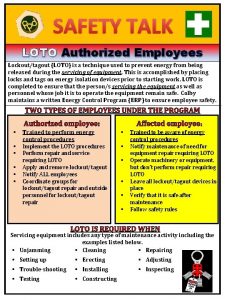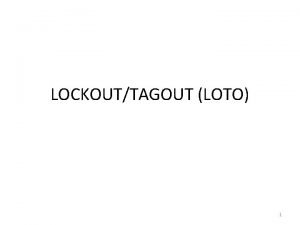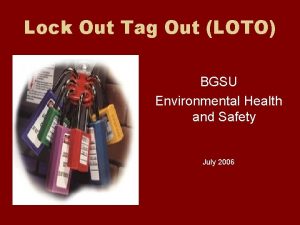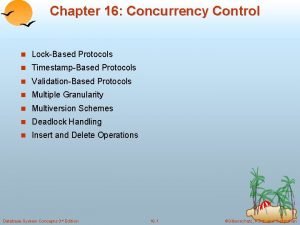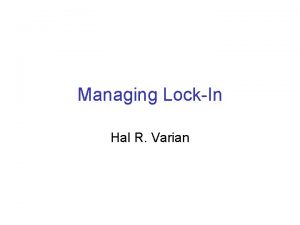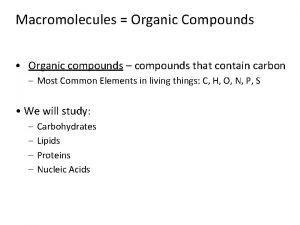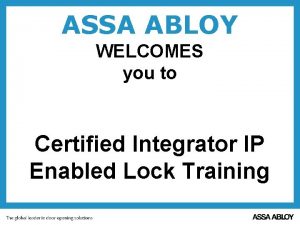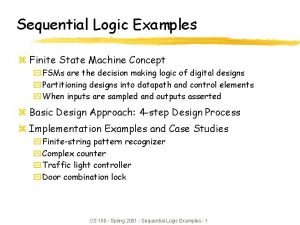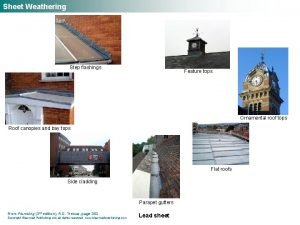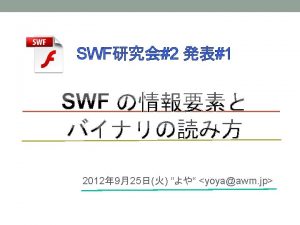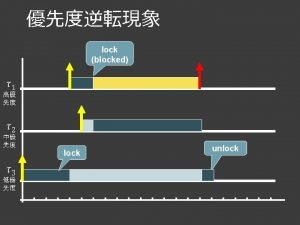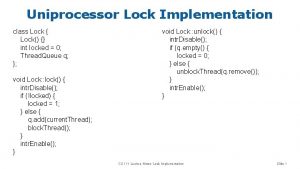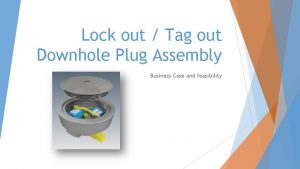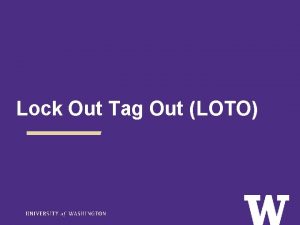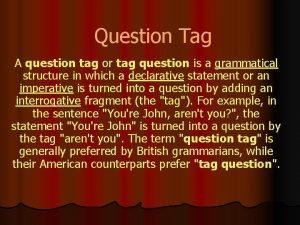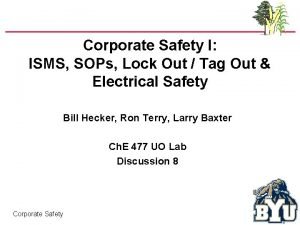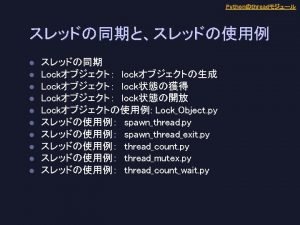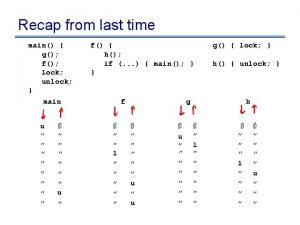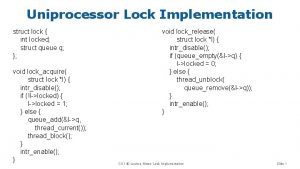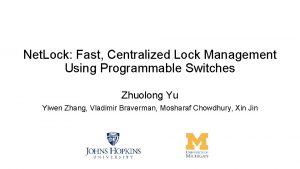Lock Out Tag Out Michael Vangeli 1242022 1




























- Slides: 28

Lock Out Tag Out Michael Vangeli 1/24/2022 1

The Control of Hazardous Energy Operating Procedure AKA Lock-Out/Tag-Out n n n 1/24/2022 AKA EHS 002 Effective Date: 10/95 http: //www. smu. edu/riskmgmt/gene ral-safety/hazardous-energy. asp 2

Topics of Discussion n 1/24/2022 SMU’s procedures for Lock. Out/Tag-Out 3

Responsibility n n 1/24/2022 3. 1 Department Heads and/or Directors -- are responsible for ensuring that this procedure is implemented within their departments, when applicable, and that all authorized and affected personnel fully comply. 3. 2 Department Managers and/or Supervisors -- are responsible for identifying and providing the appropriate training for all authorized and affected employees and for ensuring all employees comply with this procedure. The manager or supervisor shall maintain a list of all employees authorized to perform lockout/tagout (see Exhibit 1). This list should be updated at least annually or whenever a new employee has completed the required training. 3. 3 Employees -- are responsible for complying with the requirements of this procedures. Only authorized employees are permitted to lock out or tag out machines or equipment. 3. 4 Environmental Health & Safety (EH&S) Department -is responsible for the development and maintenance of this procedure, providing training and equipment resources, and for performing routine audits of all affected operating units and/or departments for compliance to this procedure. 4

Definitions n n n 1/24/2022 4. 1 Affected employee -- any employee whose job is directly impacted by the lockout/tagout of a machine or equipment that they are authorized to operate. 4. 2 Authorized employee -- any employee or person who is authorized to remove from service or shut down any equipment or machine in order to perform servicing or maintenance. 4. 3 Capable of being locked out -- an energy isolating device is capable of being locked out if it has a hasp or other means of attachment to which, or through which, a lock can be affixed, or it has a locking mechanism built into it. 4. 4 Energized -- any machine or equipment which is connected to an energy source or containing residual or stored energy. 4. 5 Energy isolating device -- a mechanical device that physically prevents the transmission or release of energy, including but not limited to the following: a manually operated circuit breaker; a disconnect switch; a slide gate; a slip blind; any line valve (ball or gate); a mechanical block; and any similar used to block or isolate energy. NOTE: Push buttons, selector switches and other control circuit type devices are not acceptable energy isolating devices. 4. 6 Energy source -- any source of electrical, mechanical, hydraulic, pneumatic, chemical, thermal or other energy. 4. 7 Lockout -- the placement of a lockout device on an energy isolating device (as defined in 4. 5) ensuring that the energy isolating device and the equipment being controlled cannot be operated. 4. 8 Lockout device -- any device that utilizes a positive means such as a lock, either key or combination type, to hold an energy isolating device in a safe position to prevent the energizing (start-up) of a machine or equipment. Blank flanges and bolted slip blinds are included as a positive means lockout device. 4. 9 Servicing and/or maintenance activities -- includes activities such as constructing, installing, setting up, adjusting, inspecting, modifying, lubricating, cleaning or unjamming of machines or equipment, etc. , where an employee may be exposed to the unexpected energization or start-up of the equipment or release of stored energy. 4. 10 Tagout -- the placement of a tagout device on an energy isolating device to indicate that the energy isolating device and the equipment being controlled may not be operated. 4. 11 Tagout device -- a prominent warning or danger tag that can be securely attached to the energy isolating device that identifies the department and employee who is performing the servicing and/or maintenance activities and the date of the activities. 5

Definitions n 4. 1 Affected employee -- any employee whose job is directly impacted by the lockout/tagout of a machine or equipment that they are authorized to operate. § 4. 2 Authorized employee -- any employee or person who is authorized to remove from service or shut down any equipment or machine in order to perform servicing or maintenance. 1/24/2022 6

Definitions n 4. 8 Lockout device -- any device that utilizes a positive means such as a lock, either key or combination type, to hold an energy isolating device in a safe position to prevent the energizing (start-up) of a machine or equipment. Blank flanges and bolted slip blinds are included as a positive means lockout device. § 4. 11 Tagout device -- a prominent warning or danger tag that can be securely attached to the energy isolating device that identifies the department and employee who is performing the servicing and/or maintenance activities and the date of the activities. 1/24/2022 7

4. 8 Lockout device 1/24/2022 8

General Rules n n n 1/24/2022 5. 1 A tagout device shall only be used as the sole method of energy control when an energy isolating device is not capable of being locked out. 5. 2 A lockout device shall always be utilized when any energy isolating device is capable of being locked out. In addition to the lockout device, a lockout/tagout permit tag (see Exhibit 2) shall also be attached to the lockout device that identifies the department and employee performing the lockout and the affected date(s) of the activity. 5. 3 Whenever replacement, major repair, renovation or modification of a machine or piece of equipment is performed, and whenever new machines or equipment are installed, energy isolating devices shall be designed and/or installed to accept a lockout device. 9

6. 0 Lockout/Tagout Procedures n 1/24/2022 Each operating unit and/or department shall ensure that all authorized employees comply with the following procedures when performing a lockout/tagout for servicing or maintenance activities. Authorized employees shall use the lockout/tagout permit tag to ensure compliance with these established procedures. 10

6. 0 Lockout/Tagout Procedures n n 1/24/2022 6. 1 Notification of affected employees -- notify each affected employee (as defined in Section 4. 1) that servicing or maintenance will be performed on a specific machine or piece equipment requiring the equipment or machine to be shut down and locked out of service. When the lockout/tagout involves the removal from service or shut down of a buildings utilities such as water, HVAC systems, etc. , notification to the building manager will suffice. 6. 2 Identification of energy sources -- identify all types and magnitude of energy that the specific machine or equipment utilizes, and identify the appropriate type of device that will be used to lockout/tagout the identified energy source(s). 11

6. 0 Lockout/Tagout Procedures n n 1/24/2022 6. 3 Equipment shutdown -- if the equipment or machine is operating, shut it down by the normal stopping procedure (depress stop button, open switch, close valve, etc. ). 6. 4 Isolate energy source -- de-activate the energy isolating device(s) so that the equipment or machine is isolated from the energy source(s), and apply appropriate lockout/tagout device. 12

6. 0 Lockout/Tagout Procedures 6. 5 Application of lockout/tagout device -- a lockout or tagout device shall be affixed to each energy isolating device by the authorized employee(s). § § 1/24/2022 a. The lockout device shall be affixed in such a manner as to hold the energy isolating device in a “safe” or “off” position. b. The tagout device (permit tag) shall be affixed in such a manner as to clearly indicate that the operation of the machine or equipment is strictly prohibited. c. When the tagout device cannot be directly affixed to the energy isolating device, the permit tag shall be located as close as is safely possible to the device, in a position that will be immediately obvious to anyone attempting to operate the device. d. When servicing and/or maintenance involves employees from different departments or involves SMU personnel working with outside contractors, the lockout/tagout shall be performed in accordance with the guidelines identified in Section 8. 0, Group lockout/tagout procedures. 13

6. 0 Lockout/Tagout Procedures 6. 6 Release of stored/residual energy -- stored or residual energy shall be dissipated or restrained by methods such as grounding, repositioning, blocking, bleeding down, etc. n a. Potential sources of stored or residual energy can include capacitors, springs, elevated machine members, rotating flywheels, hydraulic systems, and air, gas, water or steam pressure, etc. . n b. Any equipment or machine with stored or residual energy that has not been rendered safe shall be considered energized equipment. 1/24/2022 14

6. 0 Lockout/Tagout Procedures 6. 7 Verification of isolation -- the authorized employee(s) shall ensure that the equipment is disconnected from the energy source(s): na. First check that no personnel are exposed to the energy source(s) n nb. Operate the start button or other normal operating control(s) to verify the equipment or machine will not operate nc. Return the operating control(s) to the neutral or “off” position. Once all the procedures have been followed and verified, the equipment or machine is now locked out and/or tagged out and ready for servicing or maintenance. 1/24/2022 15

7. 0 Restoring Equipment To Service n When the servicing or maintenance is completed and the equipment or machine is ready to return to normal operating condition, the following steps shall be followed. 7. 1 Check machine or equipment -- the authorized employee(s) shall check the machine or equipment and the immediate area around the machine or equipment to ensure that nonessential items (tools, parts, etc. ) have been removed and that the equipment or machine components are operationally intact. 7. 2 Check work area -- check the work area to ensure that all employees have been safely positioned or removed from the area. 1/24/2022 16

7. 0 Restoring Equipment To Service 7. 3 Remove lockout/tagout devices -- each lockout/tagout device shall be removed from the energy isolating device(s) only by the employee who applied the device. The equipment or machine is then ready to be re-energized and return to normal service or operation. 7. 4 Notify affected employees -- notify each affected employee (as defined in Section 4. 1) that the servicing and/or maintenance is completed and that the machine or equipment is ready for use. For utility shutdowns notification of the appropriate building manager(s) is sufficient. 1/24/2022 17

7. 0 Restoring Equipment To Service 7. 5 Unauthorized removal -- removal or tampering with a lockout/tagout by any personnel other than the authorized employee, unless authorized by the manager or supervisor as directed in Section 7. 6, will result in disciplinary action, including up to immediate termination. 1/24/2022 18

7. 0 Restoring Equipment To Service 7. 6 Exception: when an authorized employee who applied the lockout/tagout device(s) is not available to remove it, the device(s) may be removed under the direction of the manager or supervisor only if: a. It has been verified that the authorized employee who applied the device(s) has left the campus and/or cannot be contacted b. The responsible manager/supervisor has verified that all work has been completed and it is safe to return the equipment/machine to service; and c. The manager/supervisor ensures that the employee is notified of the device(s) removal upon their return to work. 1/24/2022 19

8. 0 Group Lockout/Tagout Procedures When servicing or maintenance is being performed by several employees from different departments or by University employees working with outside contractors, the following procedures shall be followed: 1/24/2022 20

8. 0 Group Lockout/Tagout Procedures n n 1/24/2022 8. 1 Lockout/tagout coordinator -one authorized employee from the University shall be designated as having overall responsibility for coordinating the lockout/tagout; 8. 2 Personnel accountability -the lockout/tagout coordinator shall identify all personnel who will be working under the lockout/tagout; 21

8. 0 Group Lockout/Tagout Procedures n 1/24/2022 8. 3 Group lockout/tagout -- each authorized employee involved in the lockout/tagout shall affix their personal lockout/tagout device to the group lockout/tagout device (gang clasp), group lockbox, or comparable mechanism prior to starting working. Each authorized employee shall remove only their device when the lockout/tagout is complete. 22

8. 0 Group Lockout/Tagout Procedures n 1/24/2022 8. 4 Shift or personnel changes -- if a lockout/tagout is to be continued or extended to the next shift, each off-going authorized employee shall remove their device and the personnel coming on shall apply their device to the appropriate energy isolating device(s). If the oncoming shift will not be performing any service or maintenance activities on the equipment or machine and it is not ready for return to service, the original authorized employees who initiated the lockout/tagout shall leave their devices in place until completion of the process. 23

9. 0 Outside Service or Contract Personnel n n 1/24/2022 9. 1 Whenever outside service or contract personnel are to be engaged in servicing or maintenance activities that requires lockout/tagout procedures, the University’s liaison or project coordinator and the contractor’s supervisor shall inform each other of their respective lockout/tagout procedures. 9. 2 The University’s liaison or project coordinator shall ensure that all affected University personnel understand comply with the outside contractor’s lockout/tagout procedures. 24

10. 0 Training n 1/24/2022 10. 1 Prior to initial involvement in lockout/tagout procedures, authorized employees will be trained in the recognition of applicable hazardous energy sources, the type and magnitude of the energy available in the workplace, and the methods and means necessary for energy isolation and control. 25

10. 0 Training n 1/24/2022 10. 2 All managers and supervisors shall instruct their affected employees in the purpose and use of lockout/tagout and the University’s procedures upon implementation of this procedure. New employees shall receive instruction at the time of their hiring. 26

10. 0 Training n 1/24/2022 10. 3 Retraining will be provided to each authorized employee whenever there is a change in job assignment, a change in equipment or machines that would pose a new hazard or whenever a change occurs in the University’s procedures for lockout/tagout. 27

10. 0 Training § § 10. 4 Each department or operating unit shall document that training has been performed and is being kept up to date. It is recommended that all departments use the documentation format contained in Exhibit 3. Contact the Environmental Health and Safety Department for the following forms: § § § 1/24/2022 Authorized Employee List Form Lockout/Tagout Permit Tag Form EH&S Training Documentation Form 28
 Lock out tag out safety talk
Lock out tag out safety talk Lock ouy
Lock ouy Criteri di storicità dei vangeli
Criteri di storicità dei vangeli Log out tag out deutsch
Log out tag out deutsch How to write banter
How to write banter Ein neuer morgen ein neues leben
Ein neuer morgen ein neues leben Guten tag guten tag hallo wie gehts
Guten tag guten tag hallo wie gehts Metaphors in one direction songs
Metaphors in one direction songs Adrian lock
Adrian lock Cewnik permanentny do dializy
Cewnik permanentny do dializy Teddy v lock chute
Teddy v lock chute What are two pitfalls (problems) of lock-based protocols
What are two pitfalls (problems) of lock-based protocols Amalgam pin length
Amalgam pin length Lets get a lock for this thing cartoon
Lets get a lock for this thing cartoon The rape of the lock canto 5 summary
The rape of the lock canto 5 summary The protocol ensures freedom from deadlock.
The protocol ensures freedom from deadlock. Anderson queue lock
Anderson queue lock Koshland induced fit theory
Koshland induced fit theory Lock-in strategy examples
Lock-in strategy examples Lock and key model
Lock and key model Indications and contraindications of rpd
Indications and contraindications of rpd Paxos lock
Paxos lock Assa abloy lock configuration tool
Assa abloy lock configuration tool Fsm digital logic
Fsm digital logic Fairest of mortals thou distinguish'd care explanation
Fairest of mortals thou distinguish'd care explanation Lock and key
Lock and key Injection lock pll
Injection lock pll Ortoprotez
Ortoprotez Sheet weathering
Sheet weathering
